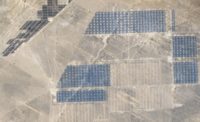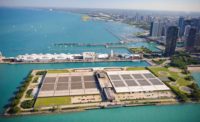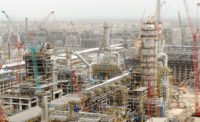Hydropower produces 16% of the world’s electricity and plays a strong role in satisfying the national energy needs of certain countries. Paraguay produces all of its electricity from hydropower, while exporting most of its excess supply to neighboring Brazil and Argentina. Albania, Bhutan and Lesotho also depend exclusively on hydroelectricity. Norway produces more than 98% of its electricity from hydropower, Brazil draws upon it for 85%, Iceland for 80%, Venezuela for 69%, Colombia for 65% and Canada for 61%. Austria (60%), Switzerland (56%) and New Zealand (53%) are other countries that generate the majority of their electricity from hydro sources. (The U.S. draws only 6% of its electricity from hydropower.)
In overall terms, China is the largest hydroelectricity producer, generating 721 terrawatt-hours (TWh) in 2010, which represented 17% of its electricity consumed. Canada ranks second, at 369 TWh in 2009, and Brazil is third, at 363 TWh, with the U.S. fourth at 250 TWh and Russia fifth at 167 TWh.
But hydropower is a resource governed by geographic restraints. “You need water and a change in elevation. That cuts out a lot of the world right away,” says Chris Bergesen, Editorial Director, UDI Products, Platts, a unit of McGraw Hill Financial, of which ENR is a part.
“Hydropower development is taking place disproportionately in developing countries, because the U.S., Western Europe and Japan are built out, essentially,” says Bergesen. The six nations that are advancing hydropower projects most ambitiously are China (82,492 MW worth of projects currently in the pipeline), Brazil (20,562 MW), India (15,328), Turkey (7,904 MW), Ethiopia (6,874 MW) and Pakistan (6,143 MW), according to Platts UDI World Electric Power Plants Data Base.
The largest-capacity hydropower plant being built in the world is the Xiluodu Dam, on the Jinsha River (the upper Yangtze River) in southwest China’s Yunnan Province. The 285-m-tall, 700-m-long concrete arch dam will contain eighteen 770-MW turbines, for a total capacity of 13,860 MW. The first turbine was commissioned in July 2013, with the remainder expected to go online later in 2014.
Brazil has one of the most robust dam-building programs of any country. The largest dam currently under construction there, Belo Monte, on the Xingu River in northeastern Brazil, is a complex of three dams, numerous dikes and a set of canals that will supply water to two power stations. The planned capacity of 11,233 MW will rank it as the third or fourth largest-capacity hydropower plant in the world when it is completed. It is being built by the Belo Monte Construction Consortium, at an estimated cost of $14.4 billion. CCBM is led by contractor Andrade Gutierrez, along with Odebrecht and Camargo Corea, and seven other smaller contractors. Construction began in 2011, but has been halted several times by courts reacting to environmental lawsuits and legal actions by indigenous peoples. The current workforce is 28,000. Most of its turbines are expected to begin producing power in 2015.
The Jirau Dam is taking shape on the Madeira River, in western Brazil near the border of Bolivia. It is a 1,500-m-long, 63-m-high rock-fill dam with an asphalt-concrete core, which will produce 3,750 MW. It will supply electricity to São Paulo, 1,400 miles away. Camargo Correa is the primary contractor, with 20,000 workers currently engaged. It is expected to be completed in 2015, at a cost of $8 billion.
Ethiopia’s current dam-building effort will lift its generating capacity from approximately 2,000 MW at present to 10,000 MW within the next three to five years.
The Gilgel Gibe III Dam, under construction on the Omo River by Salini Costruttori of Italy, will be the largest hydroelectric plant in Africa when completed, with a capacity of 1,870 MW. It is 75% finished, with no completion date announced.
The Grand Ethiopian Renaissance Dam, currently being built on the Blue Nile near the Sudan border, also by Salini Costruttori, will be the largest hydropower plant in Africa upon its completion in 2017, leapfrogging over Gilgel Gibe III. A roller-compacted concrete dam measuring 170 m tall and 1,800 m long, it will have powerhouses on each side of the spillway and will produce 6,000 MW. Much of the power generated by Ethiopia’s new dams is likely to be sold to its neighbors, including Kenya, Sudan, Djibouti and possibly Egypt. Its construction cost is $4.8 billion.
The Grand Ethiopian Renaissance Dam has engendered political tensions with downstream neighbors Sudan and Egypt. Egypt in particular fears that a temporary reduction of water flow in the Nile during the filling of the dam may hurt its farmers. Water loss via evaporation from the dam’s reservoir is another concern. It may also permanently lower the water level in Lake Nasser, thereby reducing the generating capacity of Egypt’s Aswan Dam. Egypt, Ethiopia and Sudan have established the International Panel of Experts to study the impact of the dam and make recommendations for cooperative approaches.
The benefits of large dams are well known: irrigation, flood control, navigation improvements and power production. But they also engender a wide range of environmental consequences. They degrade water quality and block sediment flowing downstream, harming ecosystems and agriculture. They block fish migration. They flood fertile river-valley farmland and sometimes displace large numbers of residents. In tropical regions shallow reservoirs submerge large quantities of plant life, which generates large volumes of methane, a potent greenhouse gas. “Tucurui Dam [in the Amazon basin], by flooding a rainforest, triggered a new scientific discipline,” says Bergesen.
The 10 Largest-Capacity Hydropower Plants

7. Longtan Dam, China, 6,426 MW. Longtan is a roller-compacted concrete dam on the Hongshui River in the Guangzi region of southern China, about 450 miles northwest of Hong Kong. Construction lasted from 2001 to 2009, and cost $4.2 billion. It is 849 m long and 216 m high, and is currently the tallest roller-compacted concrete dam in the world. Its underground power station contains nine 714-MW turbines. It is owned by Longtan Hydropower Development Co., Ltd.
Wikimedia Commons

1. Three Gorges Dam, China, 22,500 MW. A huge plug in China�s mightiest river, the Yangtze, the Three Gorges Dam is the largest volume concrete dam in the world. It is 2,309 m long, 181 m high, and contains 14.86 million cu m of concrete. Construction began in 1994 and was completed in 2006, with a workforce that peaked at 25,000 in 1999. It contains 34 turbines: 14 in the north bank powerhouse and 12 in the south bank powerhouse; six installed underground, each of them 700 MW; and two smaller 50-MW turbines. The north and south bank powerhouses became operational in 2008, generating a total of 18,300 MW. The underground turbines began operating in 2012.
Wikimedia Commons

9. Robert-Bourassa Generating Station, Canada, 5,616 MW. Formerly known as La Grande-2, the Robert-Bourassa Generating Station is the largest of four power plants that comprise the James Bay Project in northern Quebec. The Robert-Bourassa Dam on the La Grande River is an embankment dam that is 2,835 m long and 162 m high, surrounded by 16 miles of dikes. Construction began in 1974 and finished in 1981. The generating station is located underground, 6 km downriver from the main dam, and contains sixteen 351-MW turbines. Construction of the powerhouse required blasting of 4 million cu yd of rock for 8.5 miles of access, penstock and tailrace tunnels and for the huge surge chamber and machine hall 450 ft underground. It is the largest underground power plant in the world. The prime contractor was Societe d�energie de la Baie James (SEBJ), a subsidiary of the owner, Hydro-Quebec, a public utility. Hydro-Quebec is the largest hydroelectricity producer in the world.
Hydro Quebec

2. Itaipu Dam, Brazil/Paraguay, 14,000 MW. Itaipu is a complex of four dam structures straddling the Parana River on the Brazil/Paraguay border. The main structure is a 3,114-ft-long hollow concrete gravity dam with a 357-ft-high powerhouse at its base. It tapers into a concrete buttress structure carrying the spillway. On the Brazilian side, rock and earthfill embankments stretch nearly three miles. It was built by a consortium comprised of five large Brazilian and six smaller Paraguayan firms. Work on the dam began in 1975 and was completed in 1984, with the workforce peaking at 30,000 in 1978. The powerplant contains 20 turbines, each 700 MW. The first generator started producing power in 1984, with 18 operating by 1991. The final two began operating in 2007. About 90% of the electricity is supplied to Brazil, by Furnas Centrais Eletricas, with the remainder going to Paraguay. It supplies 17.3% of Brazil�s overall electricity needs, and 72.5% of Paraguay�s.
Wikimedia Commons

10. Churchill Falls Generating Station, Canada, 5,428 MW. The generating station is supplied with water from the Smallwood Reservoir, which was created by a series of 88 dikes, totaling 64 km in length, that contain the Churchill River in western Labrador. The powerhouse was hollowed out of solid rock, 1,000 ft underground, and contains 11 turbines. It measures 972 ft long, 81 ft wide and 154 ft high. Construction began in 1967 and was completed in 1974. It is owned by the Churchill Falls (Labrador) Corp. Ltd., whose shareholders are Nalcor (the provincial energy company of the province of Newfoundland and Labrador) and Hydro-Quebec. It is operated by the Newfoundland and Labrador Hydro Co., a subsidiary of Nalcor.
Nalcor Energy

3. Guri Dam, Venezuela, 10,200 MW. Guri is situated in Necuima Canyon on the Caroni River, a major tributary of the Orinoco. Construction of the original dam structure by Kaiser Engineers was nearing completion in 1968 when several sluice gates broke. To repair them, Kaiser�s team had to build a rockfill dam to block the gates, using steel grillages and boulder �necklaces.� The repair work consumed more than four months. Construction of the powerplant followed, with the final turbine in operation by 1976, bringing its capacity to 3,000 MW. A dramatic $5.2-billion expansion got under way in 1978. The concrete dam doubled in length to 4,606 ft and added 52 m in height to reach 162 m. Five and a half miles of earthen wing dams and dikes were added also, along with a new 7,000-MW powerhouse. Upon final completion in 1986, Guri�s output accounted for 60% of the total installed capacity in Venezuela. Today it accounts for over one-third. It was the world�s largest capacity hydropower plant for several years, before being surpassed by Itaipu.
Wikimedia Commons

4. Tucurui Dam, Brazil, 8,370 MW. Tucurui is a 6.9-km-long, 78-m-high concrete gravity dam on the Tocantins River in north central Brazil. Earthfill dikes bring the total length to 12.5 km. Camargo Correa built the dam, with work starting in 1975 and the reservoir filling up by 1984. The construction cost was $5.5 billion. A second powerhouse was completed in 2007, at an additional cost of $1.35 billion. The first powerhouse contains eleven 375-MW turbines, and the second powerhouse contains twelve 350-MW turbines. The dam brought electricity to 13 million people, as well as major industrial users, such as aluminum smelters.
Arantes/Eletronorte

6. Sayano-Shushenskaya Dam, Russia, 6,721 MW. A concrete gravity-arch dam, located on the Yenisey River in south-central Siberia. It is 1,066 m long and 245 m high, and construction lasted from 1961 to 1978. Originally its powerplant contained ten 640-MW turbines, and it supplied about 70% of its electricity to four aluminum smelters owned by Rusal. In August 2009 one turbine broke loose from its casing, causing extensive damage to the generator hall and nine of the turbines, and 75 people were killed. By December 2011 five turbines had been restored and resumed operating, raising the capacity to 3,200 MW. Installation of the five remaining new turbines is expected to be completed in 2014.
Wikimedia Commons

10 Largest-Capacity Hydropower Plants
Jeff Cox/ENR

5. Grand Coulee Dam, U.S., 6,809 MW. A concrete gravity dam on the Columbia River in northeast Washington state, the Grand Coulee Dam supplies water for the irrigation of 671,000 acres in addition to producing electricity. Construction began in 1933 on a �low dam,� 88 m high, which would generate electricity but not support irrigation. After visiting the site in 1934, Pres. Franklin Roosevelt endorsed a competing �high dam� design, which would supply enough electricity to pump water to irrigate the Columbia Basin. Congress approved the high dam in 1935. The 1,592-m-long, 168-m-high dam was built by the MWAK consortium, made up of the Silas Mason Co., Walsh Construction Co. and Atkinson-Kier Co. The dam was completed in 1943, and the last of the 18 original generators was operational in 1950. During World War II a sizable portion of the electricity produced by Grand Coulee was used to supply plutonium production plants at the Hanford Engineer Works nearby. A third powerplant was added later. It was built between 1967 and 1974, and the last of its six generators went into service in 1980.
Gregg M. Erickson

8. Krasnoyarsk Dam, Russia, 6000 MW. A concrete gravity dam on the Yenisey River in south-central Siberia. It is 1,065 m long and 124 m high. Construction began in 1956, and was completed in 1972. Most of its electricity is used to supply aluminum smelters. The dam includes an electric ship elevator capable of handling ships up to 1,500 tons and up to 80 m long.
Wikimedia Commons





Post a comment to this article
Report Abusive Comment